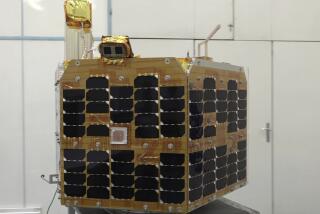Shuttle Due to Land Today After Secret Mission : Discovery Successfully Launches Sophisticated Spy Satellite on Military Flight
HOUSTON — The space shuttle Discovery is scheduled to return to Earth today after successfully launching a highly sophisticated spy satellite that is expanding U.S. use of space for military purposes.
The Air Force and National Aeronautics and Space Administration said early today that the spacecraft and its five astronauts would land at the Kennedy Space Center, Fla., if the weather is clear, at 4:33 p.m. The alternate landing site for the shuttle is Edwards Air Force Base, Calif.
The forecast for this afternoon was for partly cloudy skies, 10 m.p.h.-winds from the north, 10-mile visibility or better and no rain.
Neither the space agency nor the Air Force would comment directly on whether the three-day mission had deployed the satellite, the principal purpose for the 15th shuttle trip.
Booster Rocket Deployed
But Air Force Maj. Ron Rand said at the Johnson Space Center in Houston, where Mission Control is situated, that Discovery, on mission 51-C, had deployed an inertial upper stage booster rocket, called IUS for short, “and it successfully met its mission objectives.”
The rocket was one of the key factors in pushing a satellite from the relatively low orbit of the shuttle, ranging no higher than about 200 miles on this mission, to the 22,300-mile altitude reportedly required for the “geosynchronous” orbit of the spy satellite. That orbit places the satellite in a position over the Equator, where it travels at the same speed as the revolving Earth, keeping it, in effect, stationary.
According to published reports, the unit is intended to monitor radio and other electronic emissions from the western Soviet Union and would be used to help alert the United States to Soviet preparations for a nuclear attack.
The inertial upper stage rocket, manufactured by the Boeing Aerospace Co., failed in its previous deployment by the shuttle.
None of the problems that hampered that effort, in April, 1983, appeared to have occurred on this mission, the first shuttle flight dedicated almost entirely to military operations and flown by a group that included the first of a set of military officers specially trained to handle Defense Department cargo.
“We deployed the IUS booster rocket that was aboard 51-C,” Rand said.
Earlier, Boeing officials would not say whether their $50-million product had worked better the second time than it did the first. The 1983 failure caused the first booster to send a tracking and data relay satellite tumbling into a wrong orbit, which was corrected only when tiny built-in rockets were fired to nudge it into proper position.
The performance of the Boeing rocket, which was carried aloft in the cargo hold along with the satellite when the shuttle was launched Thursday, is crucial not only to this mission but also to the next shuttle flight. On Feb. 20, the shuttle Challenger is scheduled to take off carrying another tracking satellite and a civilian observer, Sen. Jake Garn (R-Utah).
In its report on the mission earlier Saturday, the space agency said, as it has in each of its three-times-a-day accounts, that spacecraft and crew “continue to perform satisfactorily.”
In a touch of rare verbosity on this flight, an announcement from Mission Control in Houston said that “astronaut Loren J. Shriver today asked flight controllers to pass along a happy anniversary greeting to his wife on their 17th anniversary.”
Shriver, an Air Force lieutenant commander, is the pilot. Other crew members are Navy Capt. Thomas K. Mattingly, the commander; Marine Lt. Col. James F. Buchli; Air Force Maj. Gary E. Payton, and Air Force Maj. Ellison S. Onizuka.
NASA is operating under tight constraints imposed by the Air Force, which is contributing $31.2 million of the $125 million cost of the shuttle trip. The space agency says that in keeping mum on the mission’s progress, it is only following the customer’s orders.
The Air Force fears that disclosure of the details of the project would make it easier for the Soviets to protect themselves from the satellite’s secret abilities to monitor, through two giant parabolic antennas, the radio, radar and other electronic emissions from the western Soviet Union.
More to Read
Sign up for Essential California
The most important California stories and recommendations in your inbox every morning.
You may occasionally receive promotional content from the Los Angeles Times.










